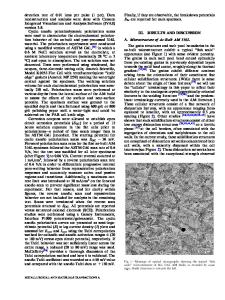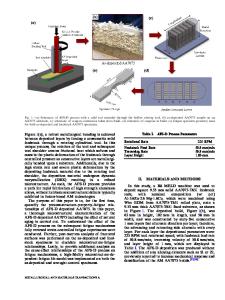Primary Processing Parameters, Porosity Production, and Fatigue Prediction for Additively Manufactured Alloy 718
- PDF / 2,753,143 Bytes
- 11 Pages / 593.972 x 792 pts Page_size
- 93 Downloads / 427 Views
JMEPEG https://doi.org/10.1007/s11665-019-04305-7
Primary Processing Parameters, Porosity Production, and Fatigue Prediction for Additively Manufactured Alloy 718 Luke Sheridan, Joy E. Gockel, and Onome E. Scott-Emuakpor (Submitted March 26, 2019; in revised form August 2, 2019) Powder bed fusion processes commonly introduce voids and defects into components. It has been shown that many of these features and their size and shape characteristics are controllable through process parameter manipulation, but this process is typically time-consuming and expensive. In spite of this, an experiment was developed to explore a wide region of laser powder bed fusion process space, and several void measurements were obtained to characterize component density percentage, pore size, and pore shape. Then, multiple models commonly used in the literature to predict porosity were examined and compared with the experimental data. Using the developed porosity model, a fatigue life prediction framework was adapted, and the predictions were compared to the previously published experimental data. Results of this investigation reveal the strengths and weaknesses of multiple literature models in predicting porosity, and they depict how porosity and resulting fatigue lives vary across process space. Keywords
additive manufacturing, alloy 718, defects, fatigue, porosity, primary processing parameters
1. Introduction Additive manufacturing (AM) has proved to be a versatile technology with promise for both current and future manufacturing endeavors. Its rapid prototyping capability is already widely used in the aerospace, medical, and automotive industries, and there is a push to extend the capability of AM to produce usable components in a variety of applications. In order for the technology to reach its full potential and utility, however, extensive process development and thorough postprocess analysis must be performed to develop sufficient qualification techniques for AM components. The processing–structure–property–performance (PSPP) relationship for materials is recognized as an important framework that guides material characterization and qualification. The large number of processing variables that are intrinsic to AM processes makes quantifying the PSPP relationship very complex. It has been shown, however, that certain primary processing parameters (PPPs) play a significant role in component density control and internal defect development Luke Sheridan, Aerospace Systems Directorate, Turbine Engine Structural Integrity Branch, Air Force Research Laboratory, 2130 Eighth St., Rm 136, Wright-Patterson Air Force Base, OH 45433; and Mechanical and Materials Engineering, Wright State University, 3640 Colonel Glenn Hwy, Dayton, OH 45435; Joy E. Gockel, Mechanical and Materials Engineering, Wright State University, 3640 Colonel Glenn Hwy, Dayton, OH 45435; and Onome E. Scott-Emuakpor, Aerospace Systems Directorate, Turbine Engine Structural Integrity Branch, Air Force Research Laboratory, 2130 Eighth St., Rm 136, Wright-Patterson Air Force Base
Data Loading...











